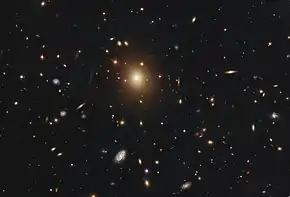Abell 2261
Abell 2261 is one of 25 galaxy clusters being studied as part of the Cluster Lensing And Supernova survey with Hubble (CLASH) program, a major project to build a library of scientific data on lensing clusters.[1]
| Abell 2261 | |
|---|---|
 Abell 2261 | |
| Observation data (Epoch 2000) | |
| Constellation(s) | Hercules |
| Right ascension | 17h 22m |
| Declination | +32° 08′ |
| Redshift | 0.224 |
| Distance | 909 Mpc (3 Gly) h−1 0.70 |
| ICM temperature | 7.6 ± 0.30 keV |
| Binding mass | 2.9 ± 0.5×1014 h−1 0.70 M☉ |
| X-ray luminosity | 18.0 ± 0.2 ×1044 erg s−1 (bolometric) |
It also has the galaxy A2261-BCG (short for Abell 2261 Brightest Cluster Galaxy) which has the one of the largest galaxy cores ever observed.[2]
In January 2021, astronomers using the Hubble Space Telescope were reported to be unable to locate a supermassive black hole presumed to be at the center of the galaxy.[3] A newer and larger space telescope, the James Webb Space Telescope, launched in December 2021, may help determine the object's whereabouts, according to the astronomers.[3]
References
- "NASA - Monster Galaxy May Have Been Stirred Up By Black-hole Mischief". www.nasa.gov. October 25, 2012. Retrieved 2016-07-15.
- "Monster Galaxy's Core Is Biggest Ever Seen". www.space.com. October 26, 2012. Retrieved 2016-07-15.
- Overbye, Dennis (19 January 2021). "Missing: One Black Hole With 10 Billion Solar Masses - One of the biggest galaxies in the universe seems to lack its dark centerpiece". The New York Times. Retrieved 19 January 2021.
This article is issued from Wikipedia. The text is licensed under Creative Commons - Attribution - Sharealike. Additional terms may apply for the media files.